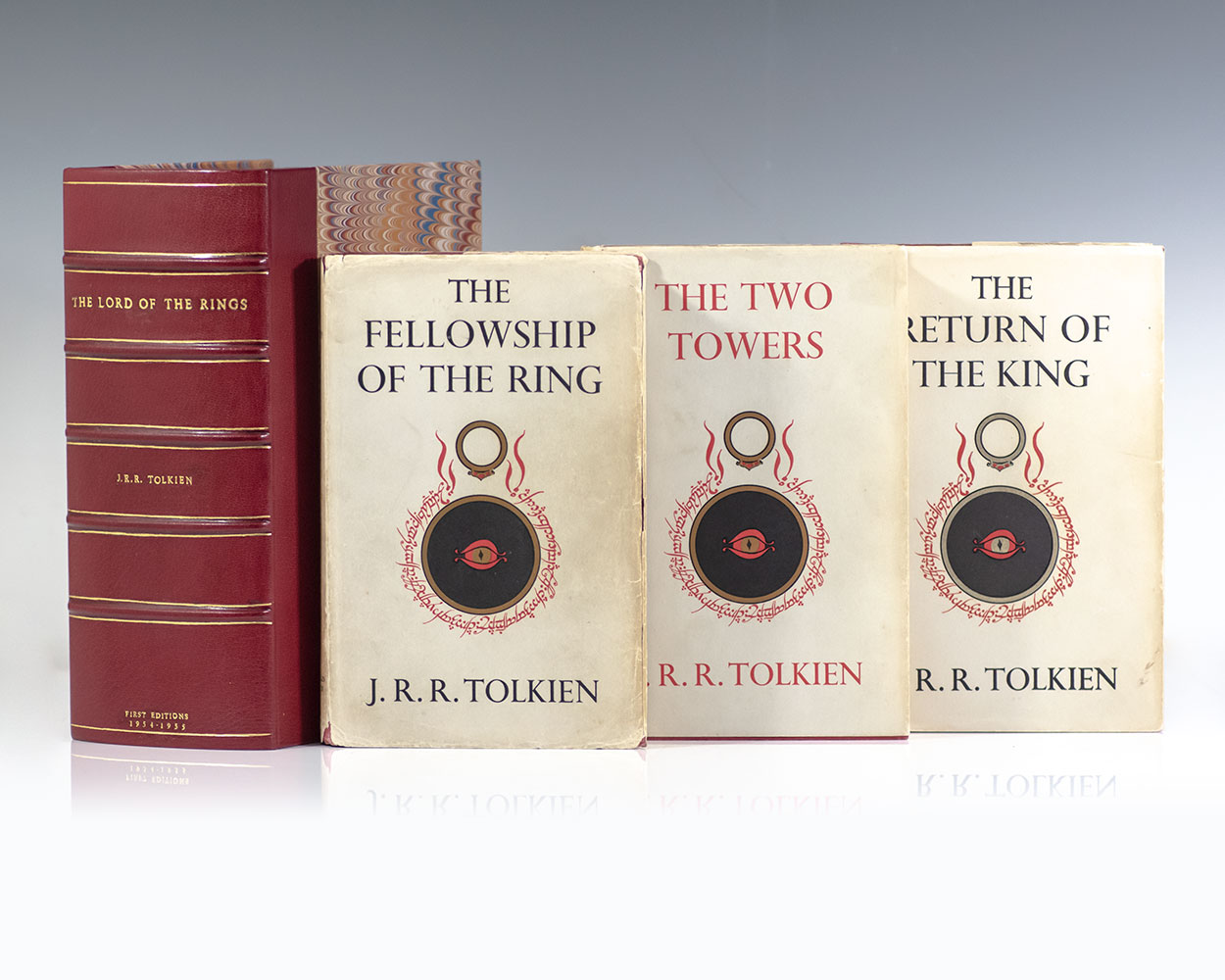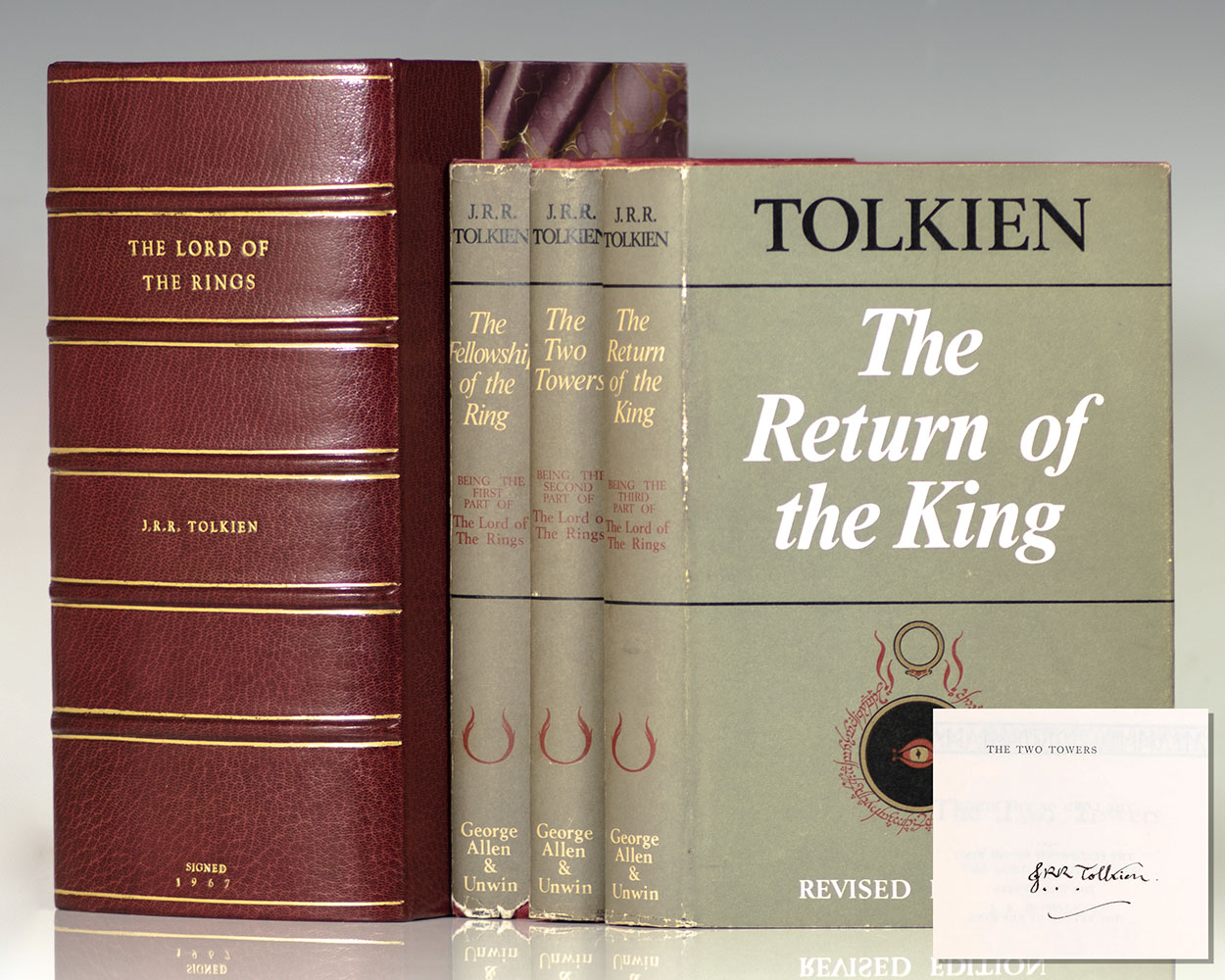The Hobbit.
Exceedingly rare first edition, first issue presentation copy of J.R.R. Tolkien's The Hobbit; inscribed by Tolkien to the Livesleys who ran the summer guest cottage in the village of Sidmouth which inspired 'The Shire' and where Tolkien did much of his writing
The Hobbit.
TOLKIEN, J.R.R.
$475,000.00
Item Number: 135801
London: George Allen & Unwin Ltd, 1937.
First edition, first issue of Tolkien’s classic tale, “among the very highest achievements of children’s authors during the 20th century” (Carpenter & Pritchard, 530), one of only a handful of presentation copies reserved for Tolkien to give to family members, colleagues and close friends. Octavo, original cloth, cartographic endpapers, frontispiece and 9 full-page uncolored illustrations after drawings by Tolkien. Presentation copy, inscribed by Tolkien on the flyleaf, “Mr. & Mrs. Livesley & Edgar with best wishes from J.R.R. Tolkien.” The recipients, the Livesleys and their son Edgar, ran the Kennaway House, a Regency town house in the village of Sidmouth, East Devon which Tolkien used as a summer holiday home and the surrounds of which inspired the landscapes, flora, and fauna of The Shire”, the region of Middle-earth inhabited hobbits first introduced in The Hobbit. Situated on the rocky coast of the rustic Devon countryside, the village of Sidmouth has featured in a number of famed literary works, as “Stymouth” in Beatrix Potter’s children’s story The Tale of Little Pig Robinson (1930), “Idmouth” in Thomas Hardy’s Wessex, “Baymouth” in William Makepeace Thackeray’s Pendennis, and “Spudmouth” in The Merry Adventures of Robin Hood by Howard Pyle. English poet Elizabeth Barrett lived in the town from 1832 until 1835. In the final stages of The Hobbit’s revisions, Tolkien notably penned a list of special recipients he wished to present copies of the first printing of the book to upon publication, including C.S. Lewis, R.W. Chambers, R.W. Chambers, Simone d’Ardenne, George S. Gordon, Elaine Griffiths, his aunts Mabel Mitton and Florence Hadley, and the Livesleys who hosted him at the Kennaway House. Published on September 21, 1937, the first printing of the Hobbit constituted only 1500 copies and completely sold out by December 15th. In near fine condition. Housed in a custom full morocco clamshell box. An exceptional association of the most highly coveted work in fantasy literature.
"In enchanted Middle-earth, a small, comfort-loving Hobbit is awakened from his slumbers by a visitor who tells of lost treasure. Before Bilbo Baggins returns home again, he journeys past wizards and elves, talkative trees and treasure-guarding dragons, all swirling in cosmic battle between good and evil. J.R.R. Tolkien's fully realized fantasy world won over generations of children, and dazzled adults with its deft interweaving of medieval legend and made-up languages, maps, and creatures. Tolkien legitimized the modern fantasy genre, and provided the 1960's counterculture with antiwar, back-to-Eden icons" (NYPL Books of the Century 199). “Professor Tolkien’s epic of Middle Earth… [is] one of [the twentieth] century’s lasting contributions to that borderland of literature between youth and age. There are few such books—Gulliver’s Travels, The Pilgrim’s Progress, Robinson Crusoe, Don Quixote, Alice in Wonderland, The Wind in the Willows—what else?… [They are] destined to become this century’s contribution to that select list of books which continue through the ages to be read by children and adults with almost equal pleasure” (Eyre, 67, 134-5). "All historians of children’s literature… agree in placing [The Hobbit] among the very highest achievements of children’s authors during the 20th century” (Carpenter & Prichard, 254, 530). Published on September 21, 1937 in a first printing of only 1500 copies, The Hobbit had completely sold out by December 15. “It may have been a surprise to its publishers that a work as sui generis as The Hobbit should have been a popular success, but once it was a success there can have been no surprise in the clamor for a sequel. Tolkien had opened up a new imaginative continent, and the cry now was to see more of it” (Shippey, 49).











